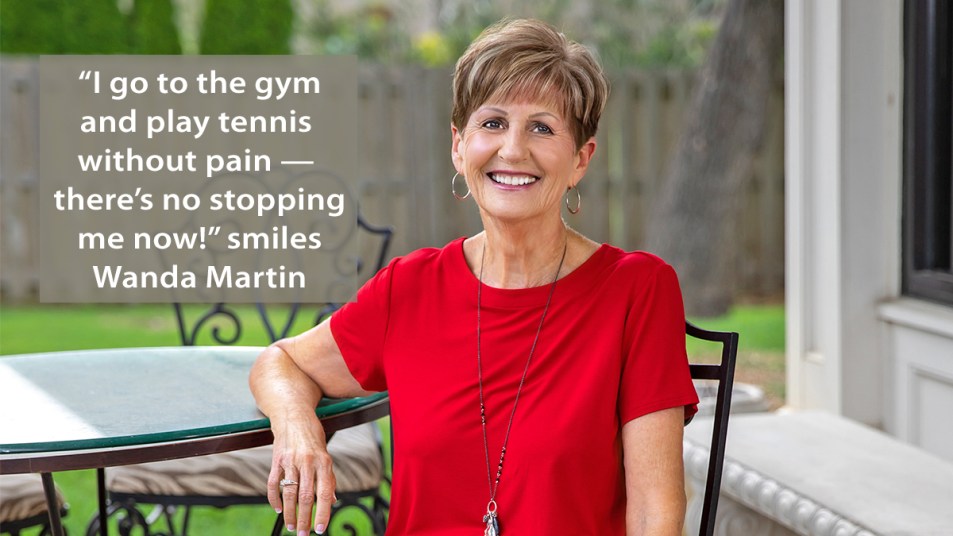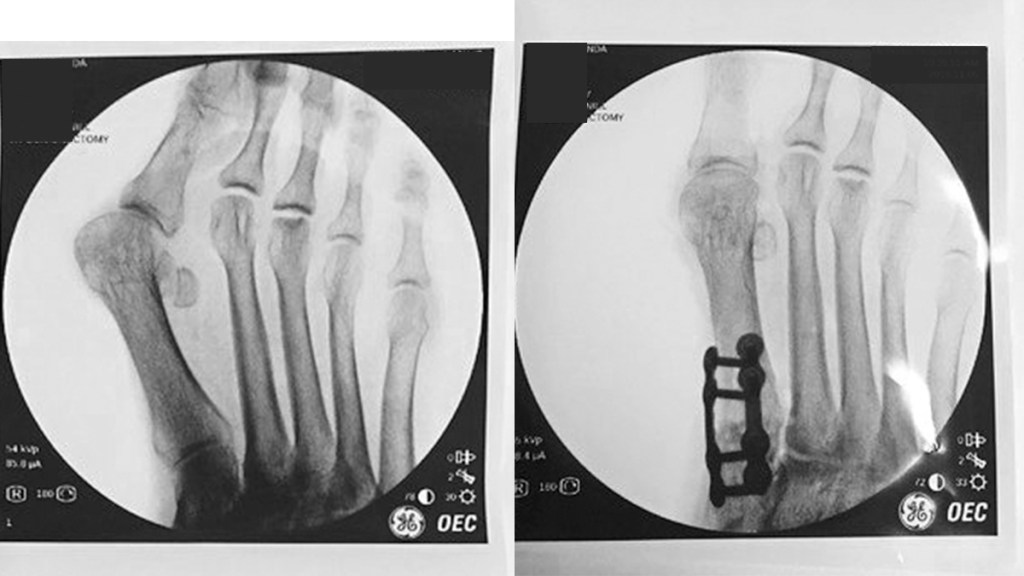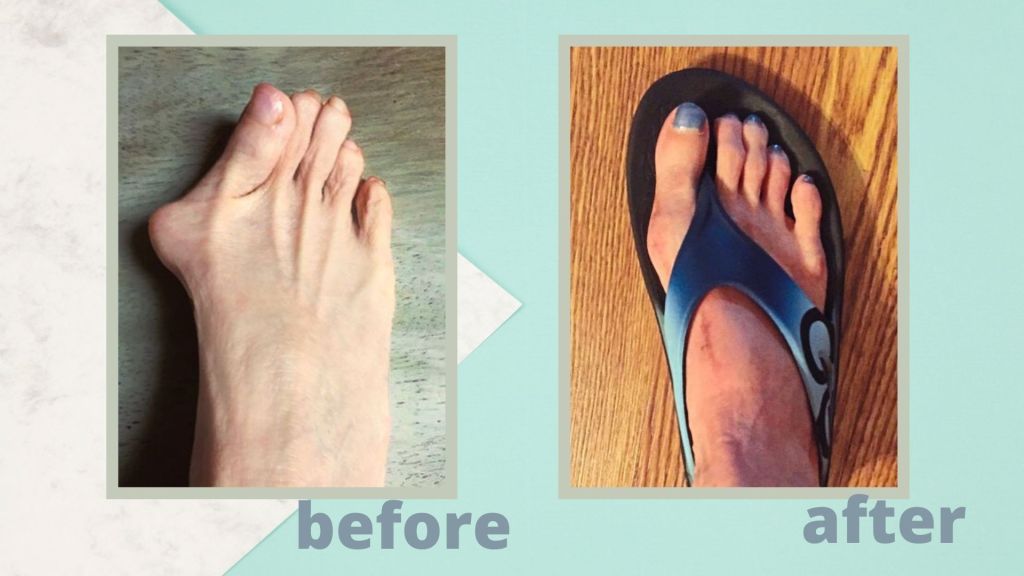“This Healed My Painful Bunions — And You Won’t Believe the Before and After!”
Wanda shares her story + her podiatrist explains how a Lapiplasty procedure speeds healing

Podiatrists and foot surgeons have traditionally relied on a surgical procedure called an osteotomy to correct bunions — or the painful bony bumps that form on the joint at the base of the big toe. The procedure involves cutting bone to reshape or realign the bones of the toe, but Daniel Tucker, DPM, a podiatrist and foot surgeon, says that an osteotomy does not address the true cause of a bunion.
“There is a misconception that a bunion is simply an overgrowth of the bone when in fact it is caused by a destabilization of the joint,” Dr. Tucker explains. “Osteotomy surgery doesn’t stabilize the joint, which is why the procedure has a bunion recurrence rate up to 78 percent.”
The solution? Dr. Tucker uses a new outpatient procedure called Lapiplasty 3D Bunion Correction, which realigns and secures the unstable joint with titanium plates at mid-foot (where the toe bone actually begins). “Lapiplasty bunion surgery fixes the root of the problem, so the rate of recurrence is only 1 percent to 3 percent,” says Dr. Tucker. “Plus there is significantly less recovery time and patients are back on their feet faster.”

Case in point: Wanda Martin, 75, suffered from painful bunions for most of her adult life. As a senior Olympian and award-winning tennis player, she had considered surgery to remove them, but she dreaded the painful recovery. Even worse, she knew there was a chance they could come back.
But then she heard about Lapiplasty and decided to give it a try, and she was miraculously back on her feet in just two weeks. Read on for Wanda’s incredible story – and her amazing bunion surgery before and after photos.
Wanda’s story: Living with painful bunions
Grimacing with each step, Wanda Martin limped off the tennis court. The then-73-year-old had always led a very active life, even competing in the Senior Olympics. But, over the past year, the pain from her bunions had become so severe, at times she could barely walk. “I have to do something,” Wanda thought. “I’m not ready to give up everything I enjoy.”
Wanda had bunions on both feet for most of her life. While some people might think they are not a big deal, bunions are a progressive and extremely painful condition. They occur when unstable bones in the foot allow the big toe to drift out of alignment. The bone protrudes from the side of the foot, causing the big toe to push inward toward the other toes, making it difficult to walk without pain.
Wanda admits initially she was mostly concerned with how her bunions looked. (Click through for more on how to straighten crooked toes.)
But as years passed, the bunions grew larger and started to interfere with her life. So, she tried all sorts of protective padding and wore wide-width shoes, which helped some, but eventually, nothing worked to ease the pain. Every step was excruciating, and Wanda realized she had to find a permanent solution. (Click through for walking shoes to help sidestep foot pain)
Lapiplasty bunion surgery gave Wanda hope
Researching options, Wanda learned the standard treatment was a surgery called osteotomy, in which doctors cut into or shave down the big toe bone to realign it.
“I would need to be completely off my feet for up to eight weeks,” she despaired to a friend. That was scary enough, but the most concerning part for Wanda was that the procedure didn’t address why the bone was drifting out of place, so her bunions could return. Not satisfied, Wanda looked further, and she was so glad she did.
Wanda discovered that there is a new outpatient procedure covered by her insurance called the Lapiplasty 3D Bunion Correction. Lapiplasty realigns the bones in the top of the foot and corrects the cause of bunions by securing the unstable joint with titanium plates. And, remarkably, she could get back on her feet in just two weeks.
What is Lapiplasty bunion surgery like?
Feeling hopeful, Wanda immediately scheduled the surgery with her doctor, Daniel Tucker, DPM, and found out that she could only do one foot at a time. So since her right foot was in much worse shape, she started with that one.
The outpatient procedure only took a couple of hours, and before Wanda left the hospital, she was given a protective boot, shown how to use it and how to change the bandages.
In the coming days, Wanda experienced some swelling and restlessness but to her relief, she wasn’t in any real pain. For the first two weeks, Wanda used a knee scooter to get around and to avoid putting weight on my foot, but then to her delight, she was allowed to start walking on her own as long as s wore the boot.
Wanda’s bunion surgery before and after

“Within six weeks, I was thrilled to be back in my tennis shoes, driving again and resuming my volunteer activities at my church and hospital,” smiles Wanda. “With traditional bunion surgery, I would still have been laid up, not being able to put any pressure on my foot for more than 2 months.”
Wanda recently had the same procedure on her other foot, but even with just one foot done, she was able to live a more active life. “I go to the gym, play tennis and walk four miles a day — without pain,” beams Wanda. “I’m even competing in the Senior Olympics again this fall. There’s no stopping me now!”
For more stories that will help you feel great, keep reading!
What Is Poor Foot Posture, and Is It Causing Your Bunions? Here’s How To Retrain Your Feet
The Surprising Link Between Estrogen and Foot Pain
4 Natural Remedies for Foot Pain That Are Backed by Podiatrists
This article originally appeared in our print magazine, First For Women.
This content is not a substitute for professional medical advice or diagnosis. Always consult your physician before pursuing any treatment plan.













